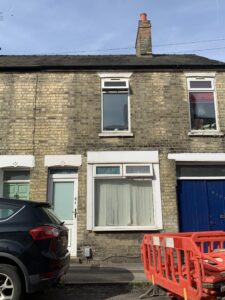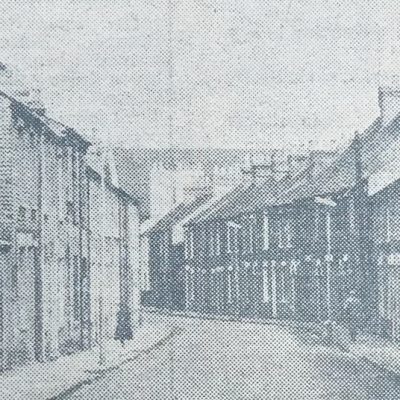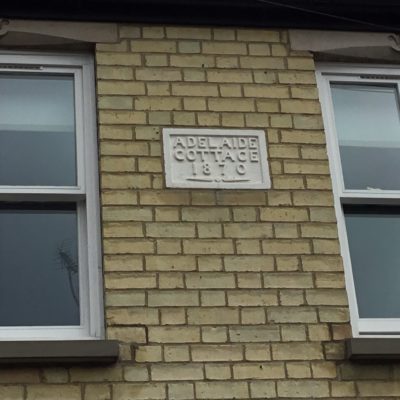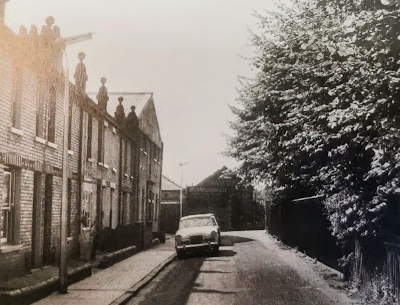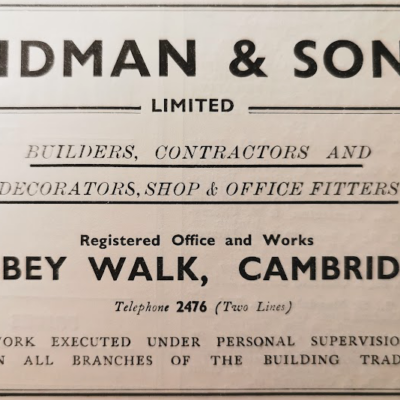Search by topic
- archaeology
- architecture
- bricklayer
- Building of Local Interest
- carpenter
- church
- crime
- dressmaker
- fire
- Great Eastern Railway
- listed building
- medieval
- oral history
- Public House
- Rattee & Kett
- Religious House
- Roman
- scholar
- school
- Then and Now
- tudor
- women
- work
- world war one
- world war two
Search by text
 9 Sturton Street, early 1900s (Cambs Collection)
9 Sturton Street, early 1900s (Cambs Collection)9 Sturton Street
The shop for Mr Cable's bakery at 9 Sturton Street is still visible as a shop frontage; photo courtesy of Cambridgeshire Collection
1891 – story of Henry Cable
In 1891 at number 9 Sturton Street lived the baker, Henry Cable, for whom we have a photograph in the Cambridgeshire Collection standing in the doorway of the shop which was adjacent to the bakery, and the co-op stables and co-op dairy shop on Sturton Street.
In 1891, Henry Cable, Baker, is listed as Head of the Household, aged 51 living with his wife, Caroline Cable, also aged 51. Living at home was their daughter, Alice, single, aged 18. It is not clear if her and her mother were helping the family business by working in the bakery shop. However, there were two assistants closeby! On the 1891 census for number 10 Sturton Street we have 5 members of the Naylor family. Their sons, Robert Naylor aged 21, and James Naylor aged 17, both have the occupation written down of ‘Bakers Assistant’ and probably were recruited directly by Henry Cable because of proximity, and one guesses must have been easy to wake up for early shifts at the bakery as they lived opposite…
Sara Payne notes in Down Your Street, 1984, that Henry Cable founded his bread-making business at no.9 in 1888. Before that he was the first Co-op baker in Cambridge. In 1871 Henry was living in Halstead with his family as a silk-weaver. In 1881 the family was living at 16 Cross Street and Henry was working as a baker. The Co-op had told him he was not only to bake the bread but push a hand-cart around selling it. He refused so the Co-op had to buy him a horse-drawn van. After he set up on his own in Sturton Street he would go out with a horse and cart and sell his bread from Abbey Road to Brookside and “over the line” – over Mill Road Bridge.
In 2003 a lovely memory of the shop was submitted to the Museum of Cambridge by J Barham, great-great granddaughter of Henry Cable who wrote the following words to the museum:
My Great-great Grandfather, Henry Cable lived at 9 Sturton Street and kept a baker’s shop with his wife Caroline. After his death, his grandson Frank Cable continued baking and delivering bread until 1948. He married Ethel Green (who lived with her family at the ‘White Hart’ on the corner of Sturton Street). They had six children (two died). Their daughter Joan was my mother.
When I was a small girl, I often stayed with my grandparents. I spent Christmas 1939 with them while my mother was having my baby sister. The tiny rooms behind the shop were crowded and there were plenty of hazards in the big bakehouse at the back including three buckets of water by the oven in case anything caught fire. One of my first sentences mimicked my Grandad saying, “Mind that water.” I remember a Christmas party in the bakehouse – I was given the fairy from the top of the Christmas tree!
Grandad kept a delivery cart under the gateway and a horse in a stable at the end of the yard. Sometimes I was allowed to ride on its back to the stable. A muck heap stood by the wall next to the stable door and the family lavatory was just behind the bakehouse a few feet away. On dark winter evenings, Grandma would hold my hand and carry a candle to light me to the loo. Toilet paper was cut up squares of newspaper (sometimes cut up by me and threaded on a string.)
Inside the house was one cold tap. I was bathed in a small tin bath in front of the fire with a saucepan of water boiled on the gas-ring and a jug of cold water. They had electricity downstairs but none upstairs until 1944. I took a candle up to bed and lay watching the moving shadows on the wall. I was sleeping there the night that the bombs fell on Vicarage Terrace.
Frank and Ethel’s daughter, Joan, married Leonard Hoskison in 1934 and in 1939 were living at 98 Lovell Road.
http://cambridgehistorian.blogspot.com/2012/12/henry-cable-sturton-street-baker.html
Other Residents of 9 Sturton Street
1881
Jesse Pilgrim lives here with his family in 1881. The census records him as a 27-year-old “cook baker & confectioner (pastry)”. He was born in Great Chesterford, Essex. His wife, Clara (nee Whiteman), is from St. Neots. They have two children who were both born in Southsea, Hampshire. Neville Arthur Whiteman is four and Owen Alfred is two.
The family have a domestic servant, 16-year-old Martha Nicholson.
In 1882 the couple have a daughter called Lottie.
The Poor Law Unions’ Gazette for 28th June 1884, records: JESSE PILGRIM, college servant, about 5ft 2in in height, black hair, dark eyes, sallow complexion, short stiff build. Wife and three children. It appears that Jesse has abandoned his family. Similar notices are made up to October 1884.
Neither Jesse or Clara can be located on the 1891 Census. Neville, Owen and Lottie are living with their Grandmother, Charlotte Whiteman, at 9 WIllow Walk. Both boys grew up to serve in World War One. Neville died in 1918.
1911
Frank [Henry] Cable, 24, baker, b Cambridge
Ethel Cable, 24, b Lincs
Sidney Cable, 4 months, b Cambridge
In 1901 Frank Cable was living at 8 Covent Garden. Ethel was living in Lincolnshire. He is described at length in Jane Barham’s Backstairs Cambridge, 1986. He would get up at 4.30 each morning to start the bread making. He sang a vast repertoire of songs.
1921
Frank Henry Cable, 35, bread baker
Ethel May Cable, 36,
Sidney Frank Cable, 10, school child
Joan Cable, 7, school child
Robert Cable, 2,
Lilian May Green, 10, visitor, father dead, school child
1939
Frank H Cable, b 1886, master baker shopkeeper
Ethel M, b 1885
Sidney F, b 1910, library assistant (blood donor)
Robert, b 1919, baker
Dorothy I, b 1922, clerk office typist National Institute for the Blind
It gradually became impossible for Frank to compete with the Co-Op store next door so he sold out and moved to a cottage in Newnham in 1948. He got a job as a gyp at Selwyn College and continued to work there until he died at the age of 73.
Robert Cable became a chorister at St John’s College. It was his elder sister Joan who had come up with the idea of entering him for the auditions in 1929 when she was 13 years old. Robert started to attend the choir school which was in a big house in All Saints’ passage. School finished at 4pm and choir practice began at 5.30pm. Robert had to run home, eat his tea and then run back. The choir master at the time was Cyril Rootham. After leaving St John’s he helped his father in the bakery. During WWII he was an army cook, working in the desert and in Greece. He brought his niece a Bicle back from Bethlehem. In 1947 he was offered a job in the kitchen at Trinity College for £3 a week. This was reduced when he started work to £2 10s! He soon moved to work as a chef at a hotel in Cambridge for £5. In 1962 Robert was living at 16 Sunnyside.
Dorothy ‘Dorrie’ left school at the beginning of WWII. Her first job was compulsory work in a aircraft factory. By the end of the war she was able to leave the factory and went to the University Library to be manageress of the tea room. (See Backstairs Cambridge, 1986 by Jane Barham). Dorothy married Jack Bloxam in 1947 in Cambridge. In 1962 Jack Bloxam is living at 54 Leete Road.
Sources: 1881, 1891, 1901, 1921 UK Census, Poor Law Unions Gazette, Lives of the First World War,
Contribute
Do you have any information about the people or places in this article? If so, then please let us know using the Contact page or by emailing capturingcambridge@
License
This work is licensed under CC BY-NC-SA 4.0








